-
 Bitcoin
Bitcoin $118300
-0.58% -
 Ethereum
Ethereum $3825
0.11% -
 XRP
XRP $3.137
-0.71% -
 Tether USDt
Tether USDt $0.9999
-0.01% -
 BNB
BNB $803.9
-3.37% -
 Solana
Solana $181.5
-1.94% -
 USDC
USDC $0.9999
0.01% -
 Dogecoin
Dogecoin $0.2238
-2.51% -
 TRON
TRON $0.3358
2.12% -
 Cardano
Cardano $0.7844
-2.16% -
 Hyperliquid
Hyperliquid $43.31
-1.48% -
 Sui
Sui $3.807
-4.04% -
 Stellar
Stellar $0.4203
-1.96% -
 Chainlink
Chainlink $17.79
-3.00% -
 Bitcoin Cash
Bitcoin Cash $567.8
-1.34% -
 Hedera
Hedera $0.2614
-4.30% -
 Avalanche
Avalanche $24.19
-4.46% -
 Litecoin
Litecoin $109.2
-0.74% -
 UNUS SED LEO
UNUS SED LEO $8.969
-0.01% -
 Toncoin
Toncoin $3.404
3.97% -
 Ethena USDe
Ethena USDe $1.001
-0.01% -
 Shiba Inu
Shiba Inu $0.00001307
-3.19% -
 Uniswap
Uniswap $10.33
-1.23% -
 Polkadot
Polkadot $3.884
-4.06% -
 Monero
Monero $312.9
-1.87% -
 Dai
Dai $1.000
0.01% -
 Bitget Token
Bitget Token $4.537
-2.24% -
 Pepe
Pepe $0.00001156
-3.40% -
 Cronos
Cronos $0.1437
-0.89% -
 Aave
Aave $282.8
-2.77%
Should I go all-in when the MTM momentum breaks through?
An MTM breakout in crypto signals rising momentum, but going all-in is risky—confirm with volume, price action, and use strict risk management to avoid false signals.
Jul 29, 2025 at 06:07 am
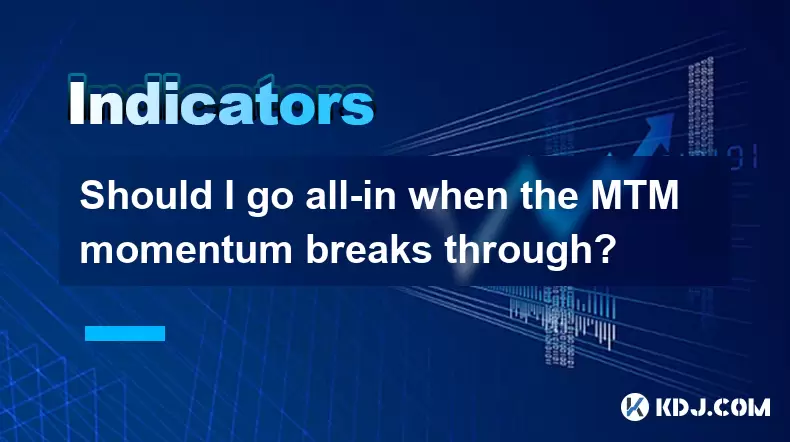
Understanding MTM Momentum in Cryptocurrency Trading
The MTM (Momentum) indicator is a technical analysis tool used to measure the rate of change in a cryptocurrency’s price over a specific period. It calculates the difference between the current closing price and the closing price from a set number of periods ago. When the MTM value crosses above zero, it signals upward momentum, while a cross below zero indicates bearish momentum. Traders use this to identify potential trend reversals or continuations. A breakout in the MTM often occurs when the momentum shifts sharply, suggesting increased buying or selling pressure.
In the context of cryptocurrency markets, which are highly volatile and prone to rapid price swings, MTM breakouts can appear frequently. A breakout above a resistance level in the MTM may indicate that buyers are gaining control. However, interpreting this signal requires context. For example, if the breakout occurs during a period of low volume or after an extended rally, it may be a false signal. Conversely, a breakout accompanied by high trading volume and confirmation from other indicators like RSI or MACD increases its reliability.
What Does “Going All-In” Mean in Crypto Trading?
“Going all-in” refers to allocating 100% of your available trading capital into a single position. In cryptocurrency trading, this strategy is extremely risky due to the market’s inherent volatility. Cryptocurrencies like Bitcoin or Ethereum can experience double-digit percentage swings within hours, making full exposure potentially devastating if the market reverses.
When traders consider going all-in on an MTM breakout, they are essentially betting that the momentum will continue in the same direction with enough strength to generate substantial returns. However, this ignores critical risk management principles. Professional traders typically limit position sizes to a small percentage of their total portfolio, often between 1% to 5%, to withstand adverse price movements. Going all-in eliminates any margin for error and exposes the trader to complete loss if the trade turns against them.
Assessing the Validity of an MTM Breakout
Before reacting to an MTM breakout, it's essential to verify its strength and context. Not every breakout leads to a sustained trend. To assess validity, consider the following factors:
- Volume confirmation: A genuine breakout should be supported by a noticeable increase in trading volume. High volume during the breakout suggests strong market participation and reduces the likelihood of a fakeout.
- Price action alignment: Check if the price is also breaking through key resistance levels on the chart. The MTM breakout should coincide with a price breakout for stronger confirmation.
- Timeframe consistency: Analyze the MTM across multiple timeframes. A breakout on the 1-hour chart may be less significant than one on the 4-hour or daily chart. Higher timeframe breakouts carry more weight.
- Market context: Is the broader market bullish or bearish? If Bitcoin is in a downtrend, an altcoin MTM breakout may lack sustainability.
Ignoring these factors and acting solely on the MTM line crossing a threshold can lead to poor decision-making.
Practical Steps to Respond to an MTM Breakout
Reacting to an MTM breakout does not require going all-in. A disciplined approach involves several measured steps:
- Wait for confirmation: Do not enter immediately when the MTM crosses a level. Wait for at least one additional candle to close beyond the breakout point to avoid false signals.
- Set a defined entry point: Use limit orders to enter at a specific price just above the breakout level to ensure precision.
- Place a stop-loss order: Protect your capital by setting a stop-loss below the recent swing low (for long positions). This limits potential losses if the breakout fails.
- Determine position size: Use a risk-per-trade model. For example, risk no more than 2% of your total capital on a single trade. Calculate the position size based on the distance between entry and stop-loss.
- Use trailing stops: If the trade moves in your favor, adjust the stop-loss upward to lock in profits and ride the momentum safely.
These steps allow you to participate in the momentum without jeopardizing your entire portfolio.
Risks of Overreliance on the MTM Indicator
The MTM indicator, while useful, has limitations. It does not account for overbought or oversold conditions on its own. A sharp MTM spike can occur during a parabolic rise, which often precedes a correction. Relying solely on MTM may cause traders to enter at the top of a pump.
Additionally, MTM is a lagging indicator in nature because it’s based on past price data. By the time the breakout is visible, part of the move may already have occurred. This increases the risk of buying high and selling low if the trend reverses quickly.
Cryptocurrency markets are also influenced by external factors such as regulatory news, exchange outages, or whale movements, which MTM cannot predict. Combining MTM with on-chain data, order book analysis, and sentiment indicators provides a more holistic view.
Alternatives to Going All-In After an MTM Breakout
Instead of committing all capital, consider alternative strategies that balance opportunity and risk:
- Scale-in entries: Allocate a portion of your capital (e.g., 25%) at the initial breakout, then add more if the price continues upward with confirmation.
- Use options or futures with defined risk: In markets that support derivatives, you can gain leveraged exposure while capping losses with options or proper margin management.
- Pair with moving averages: Only act on MTM breakouts when the price is above a key moving average, such as the 50-day or 200-day EMA, to ensure alignment with the trend.
- Monitor divergence: If the price makes a new high but MTM fails to surpass its previous peak, this bearish divergence warns of weakening momentum, even if a breakout appears to occur.
These approaches allow participation in strong moves while preserving capital for future opportunities.
Frequently Asked Questions
What is a typical MTM period setting for crypto trading?
The most commonly used MTM periods in cryptocurrency trading are 10, 14, or 20. A 10-period MTM is more sensitive and generates more signals, suitable for short-term traders. A 20-period MTM is smoother and better for identifying longer-term momentum shifts.
Can MTM be used on altcoins effectively?
Yes, MTM can be applied to altcoins, but low-liquidity coins may produce erratic signals due to price manipulation or thin order books. It’s advisable to use MTM on major altcoins like ETH, BNB, or SOL, where trading volume and market depth are higher.
How do I avoid false MTM breakouts?
Avoid false breakouts by requiring volume confirmation and waiting for candle closure. Also, filter signals using support/resistance levels and additional indicators like MACD or ADX to confirm trend strength.
Is MTM better on higher or lower timeframes?
MTM on higher timeframes (4H, daily) tends to produce more reliable signals with fewer false entries. Lower timeframes (5M, 15M) generate frequent signals but are noisier and more prone to whipsaws, especially in sideways markets.
Disclaimer:info@kdj.com
The information provided is not trading advice. kdj.com does not assume any responsibility for any investments made based on the information provided in this article. Cryptocurrencies are highly volatile and it is highly recommended that you invest with caution after thorough research!
If you believe that the content used on this website infringes your copyright, please contact us immediately (info@kdj.com) and we will delete it promptly.
- PENGU Price Plunge? Binance Transfers and Token Transfer Trends
- 2025-07-30 23:10:15
- Navigating Crypto Investment: Bitcoin Mining and the Rise of Cloud Mining in the Big Apple
- 2025-07-30 22:31:15
- Meme Coins, Profit, and Investment: Riding the Crypto Wave in Style
- 2025-07-30 23:10:15
- LivLive's Gamified AR Launch Phase: Level Up Your Reality!
- 2025-07-30 22:31:15
- Bitcoin, Crypto, and the Golden Age: Navigating the Future of Digital Assets
- 2025-07-31 00:10:14
- JPMorgan, Coinbase, and Crypto Access: A New Era for Digital Finance?
- 2025-07-30 22:50:13
Related knowledge
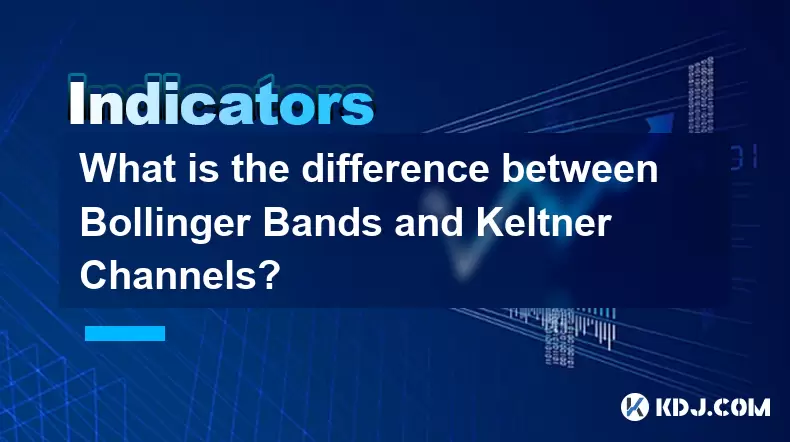
What is the difference between Bollinger Bands and Keltner Channels?
Jul 30,2025 at 11:30pm
Understanding Bollinger Bands and Their Core ComponentsBollinger Bands are a widely used technical analysis tool developed by John Bollinger in the 19...
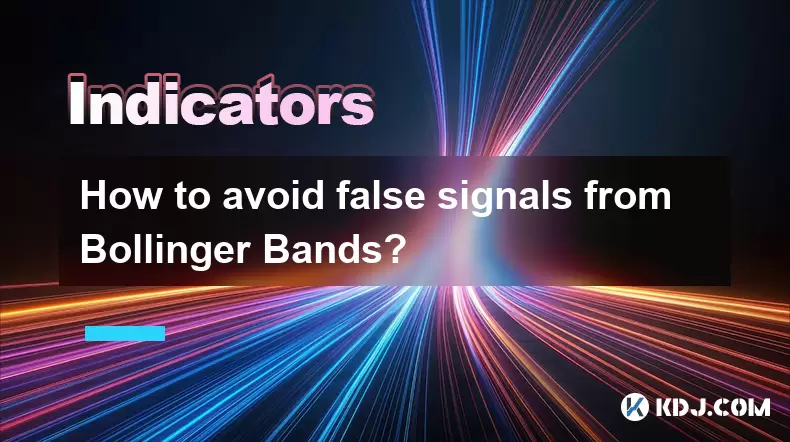
How to avoid false signals from Bollinger Bands?
Jul 30,2025 at 11:42pm
Understanding Bollinger Bands and Their Core ComponentsBollinger Bands are a widely used technical analysis tool developed by John Bollinger in the 19...
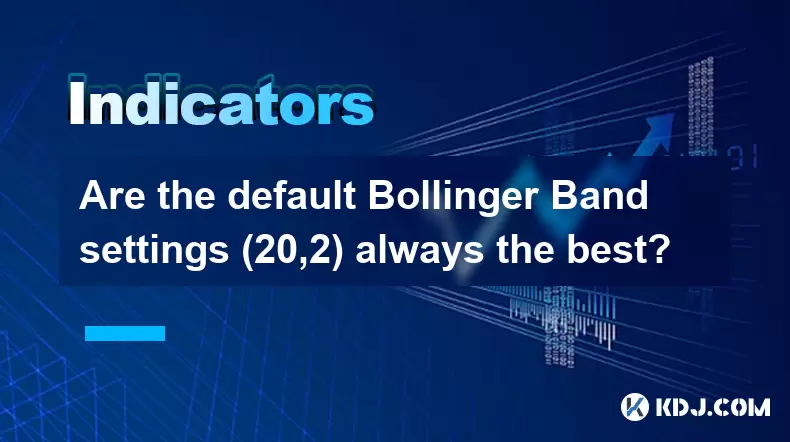
Are the default Bollinger Band settings (20,2) always the best?
Jul 30,2025 at 11:36pm
Understanding the Standard Bollinger Band ConfigurationThe default Bollinger Band settings of (20,2) are widely used across the cryptocurrency trading...

What is a head fake in Bollinger Bands?
Jul 30,2025 at 09:44pm
Understanding Bollinger Bands and Their StructureBollinger Bands are a widely used technical analysis tool developed by John Bollinger in the 1980s. T...
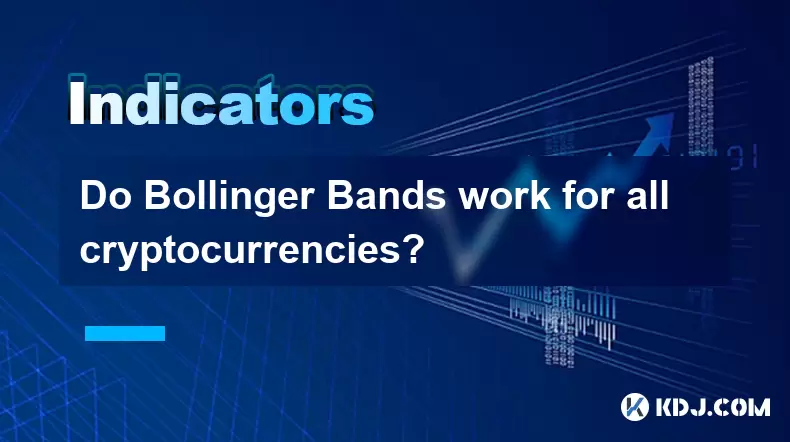
Do Bollinger Bands work for all cryptocurrencies?
Jul 30,2025 at 09:30pm
Understanding Bollinger Bands in Cryptocurrency TradingBollinger Bands are a widely used technical analysis tool developed by John Bollinger in the 19...
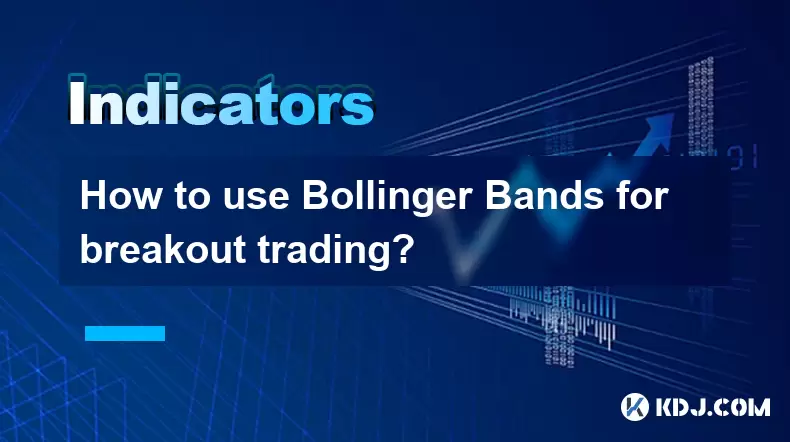
How to use Bollinger Bands for breakout trading?
Jul 30,2025 at 10:27pm
Understanding Bollinger Bands and Their ComponentsBollinger Bands are a widely used technical analysis tool developed by John Bollinger in the 1980s. ...

What is the difference between Bollinger Bands and Keltner Channels?
Jul 30,2025 at 11:30pm
Understanding Bollinger Bands and Their Core ComponentsBollinger Bands are a widely used technical analysis tool developed by John Bollinger in the 19...

How to avoid false signals from Bollinger Bands?
Jul 30,2025 at 11:42pm
Understanding Bollinger Bands and Their Core ComponentsBollinger Bands are a widely used technical analysis tool developed by John Bollinger in the 19...

Are the default Bollinger Band settings (20,2) always the best?
Jul 30,2025 at 11:36pm
Understanding the Standard Bollinger Band ConfigurationThe default Bollinger Band settings of (20,2) are widely used across the cryptocurrency trading...

What is a head fake in Bollinger Bands?
Jul 30,2025 at 09:44pm
Understanding Bollinger Bands and Their StructureBollinger Bands are a widely used technical analysis tool developed by John Bollinger in the 1980s. T...

Do Bollinger Bands work for all cryptocurrencies?
Jul 30,2025 at 09:30pm
Understanding Bollinger Bands in Cryptocurrency TradingBollinger Bands are a widely used technical analysis tool developed by John Bollinger in the 19...

How to use Bollinger Bands for breakout trading?
Jul 30,2025 at 10:27pm
Understanding Bollinger Bands and Their ComponentsBollinger Bands are a widely used technical analysis tool developed by John Bollinger in the 1980s. ...
See all articles

























































































